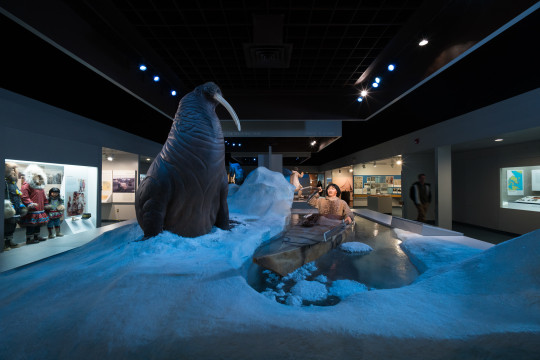By Patrick McShea

What happens in the Arctic effects all of us. The frozen seas of the northern hemisphere’s remotest territory influence the circulation patterns of ocean currents and air masses that support temperate climate conditions for land masses far to the south.
The urgent need for broader understanding of this sea ice-dependent system recently drew four dozen researchers and educators to the University of Rhode Island for a National Science Foundation -sponsored workshop titled ARISE, for Arctic Researchers and Informal Science Education.
The three-day program was designed to address two explicit goals – broadening the impact of Arctic research findings and increasing the informal science community’s engagement with Arctic scientists.
Paired sessions assured that big ideas were anchored to specific ongoing research. A formal review of proposed Polar Literacy Principles, for example, was followed by small discussion groups in which researchers explained their own observations of diminished sea ice or disrupted food webs. As an educator representing CMNH’s exhibit hall about Arctic life and extensive scientific collections from the region, I was an eager participant in every session.

Existing National Science Foundation resources were the focus of several presentations. Profiled assets ranged from the digital archive known as the Arctic Data Center to a floating mobile research platform, the 261-foot blue-hulled ice capable research vessel Sikuliaq, which is operated by the University of Alaska Fairbanks.
I did more listening than talking, learning directly from scientists about research projects that included the study of thousand- year-old clay-lined food storage pits along hard-to-reach stretches of Alaskan coast, and a “citizen science” berry survey by middle school students in remote villages that will document climate driven vegetation changes on the tundra.

When discussion opportunities arose, I shared two items I carried with me each day, the preserved hollow egg of an Arctic Loon, and a copy of Barry Lopez’s now 32-year-old masterpiece, Arctic Dreams. The three-inch long egg, a dark mustard brown with chocolate-colored flecks, bore in tiny handwritten script a collection date of 6/19/24. This 94-year-old specimen, part of the museum’s teaching collection, and sturdy enough to be carefully passed hand-to-hand, served to represent and draw attention to the museum’s own Arctic archive, the portion of preserved plants, animals, minerals, artifacts, and fossils in the museum’s scientific collections that have Arctic origins.

Arctic Dreams, which bears the subtitle, Imagination and Desire in a Northern Landscape, is a poetic 372-page chronical of Lopez’s immersion in historical Arctic exploration accounts and his own travels in the region with Arctic indigenous people, biologists, oceanographers, geologists, and oil drilling crews. The work contains repeated alarm calls about threats to the region’s delicately balanced ecosystems, but on the occasions when I passed the paperback to a workshop colleague it was to note particularly eloquent passages about narwhals, snowy owls, or muskox.
The book also provided appropriate reading material to pass flight delays on my way home from the workshop. In the crowded confines of a Reagan National Airport terminal, I re-read a section that helped me better understand my conversations with Arctic researchers.
At the close of a Chapter titled “The Country of The Mind,” Lopez recounts conversations with paleontologists Mary Dawson and Robert West during a shared plane ride between remote Canadian Arctic islands. When Dawson, then Curator of Vertebrate Paleontology at Carnegie Museum of Natural History and now curator emeritus, leaves Lopez with letters to mail at one of the plane’s later stops, the packet spurs thoughts about how we share information. Lopez wrote:
I rode for hours with the letters on the seat beside me. I thought about the great desire among friends and colleagues and travelers who meet on the road, to share what they know, what they have seen and imagined. Not to have a shared understanding, but to share what one has come to understand. In such an atmosphere of mutual regard, in which each can roll out his or her maps with no fear of contradiction, of suspicion, or theft, it is possible to imagine the long, graceful strides of human history.
The ARISE Workshop, I realized, fostered such map unrolling by creating a forum where scientists shared what they had come to understand about the state of our planet’s northern reaches. The way their messages are received and acted upon will undoubtedly influence future strides of human history.
Patrick McShea works in the Education and Visitor Experience department of Carnegie Museum of Natural History. Museum employees are encouraged to blog about their unique experiences and knowledge gained from working at the museum.
